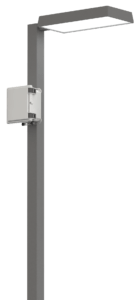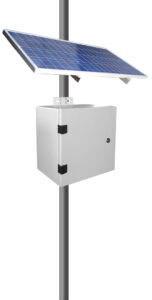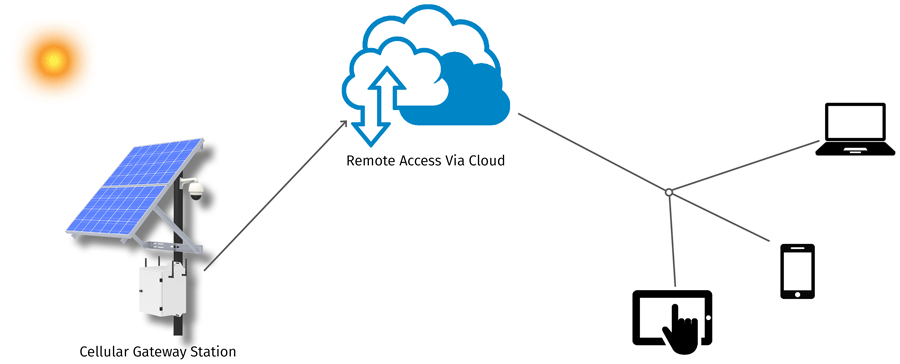Step 1 – Setting Up Wireless Surveillance Networks in Remote Areas
The purpose of this article is to provide Security Surveillance Systems Integrators with information on creating Wireless Surveillance Systems, and installing them in a variety of scenarios and environments.
After reading this information you will not only understand how to create a Wireless Surveillance System, but you will also be able to overcome any obstacles during installation caused by the type of solar power available, or the lack of power altogether.
The cost of surveillance equipment (videos, cameras, lights, gateways, etc.) has decreased significantly in recent years, leading to an increased demand. Both the surveillance, and the wireless industries have evolved considerably in a very short period of time. Systems Integrators are challenged daily with new applications, new equipment, and the obstacle of powering this new technology in harsh environments.
Pairing surveillance cameras with wireless equipment can make for a much more cost effective and easier outdoor surveillance installation. It’s much less invasive by eliminating the need to trench or run cabling.
In many instances Wireless Equipment is being installed in an area where full time 110 VAC Power is available, and an Electrician can easily bring the power to the point of installation. If you would like to learn how to installs Solar IP cameras to light poles I suggest you read this on light pole surveillance. And this is the product you’ll do it with, it’s called a VTAP – Light Pole Power Tap.
Step 2 – Choose an Outdoor IP Security Camera that’ll Work Well For Your Needs
Internet Protocol and IP Cameras
The type of camera to use in a wireless application is referred to as an IP (Internet Protocol) Camera. Unlike an analogue camera, an IP Camera can send and receive data over a computer network and the internet. IP Cameras need to be configured with an IP Address, which will be used to establish connectivity with the wireless equipment.
There are 2 primary types of IP Cameras:
- Centralized IP Cameras, which require a central network video recorder (NVR) to handle the recording, video and alarm management.
- Decentralized IP Cameras, which do not require a central NVR, as the cameras have recording function built-in and can thus record directly to any standard storage media, such as SD cards, NAS (network-attached storage) or a PC/server.
The type of IP camera that is being used will play a role in determining the approach used to establish wireless connectivity.
Step 3 – Decide How You Will Connect Wirelessly
You have 3 basic options for connecting wirelessly.
Local Point-to-Point Network
One method for achieving wireless connectivity is to create a Local Point to Point Network using Wireless Radio equipment. This method is typically used to establish connectivity with a Centralized IP Camera. This involves configuring the transmitting radio with an IP Address and setting it to communicate with the IP Camera and the receiving radio. The transmitting radio is installed at the same location as the IP Camera. The IP Camera communicates with the transmitting radio through an Ethernet Cable.
The receiving radio, also known as an Access Point is also configured with an IP Address, and is set to communicate with the transmitting radio. The Access Point, which can be many miles away from the surveillance site, is connected to an NVR (Network Video Recorder) where the video feed is captured and recorded.
The Access Point is typically located at the facility responsible for managing the property. If the NVR is also connected to the Internet, Port Forwarding can be established to allow users to connect remotely from any computer, tablet, or smart phone to view the recorded footage, or the live video feed.
Line of Sight
One thing to keep in mind when creating a Local Point to Point Network is Line of Sight. In order to communicate with one another there cannot be any obstructions between the transmitting radio and the Access Point. If Line of Sight is not achievable using two radios, you can place additional radios creating a Wireless Bridge or “Backhaul” to bridge the signal around or over obstructions.
To create a Wireless Bridge you will need two radios, one configured as the receiver and the other as the transmitter. The radio that is configured as the receiver or Access Point, is set to communicate with the transmitting radio located at the surveillance sight. The second radio is set as the transmitter, and is set to communicate with the Access Point located at the recording site. The two radios that make up the bridge communicate with one another through an Ethernet Cable and bridge the gap between the surveillance site and the recording site.
Note: This is also an effective method to increase the distance from the surveillance site to the recording site.
A Local Point-to-Point Network consisting of multiple transmitting locations, wireless bridges, and access points is referred to as a Mesh Network.
Below are a few links to wireless products that we recommend for creating a Local Point-to-Point Network for your Wireless Surveillance system.
Cellular Gateway
Another popular method for establishing wireless connectivity for your surveillance system is to use a Decentralized IP Camera with capacity for local storage such as an SD Card, or a Solid State Recording feature. This type of camera can be paired with a Cellular Gateway which will allow the user to log into the camera remotely over their Cellular Network.
An important thing to keep in mind when accessing your IP Camera over a Cellular Network, is that this option requires a Data Package from a Cellular Provider with a monthly fee, and will have limitations on Data usage. Due to the limitations on Data usage, broadcasting the video feed over the Cellular Network to a recording device is not an option. This is why it is recommended to use an IP Camera with capacity for local storage. This approach will only use Data on the user’s Cellular Plan when logging into the IP Camera over the Cellular Network to view recorded events, or the live video feed.
Step 4 – Choose the Correct Operating Voltage for Your Camera’s Configurations
Power Over Ethernet (PoE)
Now that we understand how to establish wireless connectivity to our surveillance system, the next challenge is powering the IP Equipment. The challenge is that the vast majority of equipment used to create a Wireless Surveillance System doesn’t operate at 110 VAC, which is the standard voltage provided at any NEMA Outlet.
If the wireless surveillance system is being installed indoors, this is less of an obstacle. Most IP Cameras and Wireless Equipment will come with a power supply that will convert the available 110 VAC from any standard Nema outlet to the appropriate operating voltage of the equipment.
For outdoor applications however, it’s important to verify that the power supply is weather-proof and has an Operating Temperature Range that is appropriate for the environment. This information should be available on the Spec Sheet for the IP Equipment.
Most IP Equipment will have the option to operate on a specialized type of power known as Power over Ethernet or PoE. This type of power allows the Ethernet Cable that is providing the communication between devices, to also provide power to the equipment.
Network cables, such as Cat 5e and Cat 6, comprise eight wires arranged as four twisted pairs. In 10 and 100BASE-T Ethernet, two of these pairs are used for sending information. These are known as the Data Pairs. The other two pairs are unused, and are referred to as the spare pairs (Gigabit Ethernet uses all four pairs).
Because electrical currents flow in a loop, two conductors are required to deliver power over a cable. PoE treats each pair as a single conductor, and can use either the two data pairs or the two spare pairs to carry electrical current.
To Learn more about Power over Ethernet, please click the link below to access Vorp Energy’s Learning Center.
Injecting Power over Ethernet
Providing PoE Power to IP Equipment requires a specialized device called a PoE Injector. PoE Injectors are voltage converters that will typically accept an input voltage of 110 VAC, and convert it to usable DC Voltage that can be passed along the twisted pairs of an Ethernet Cable. There are also PoE Injectors that accept a wide range of DC Voltage and provide the appropriate PoE Power to the IP Equipment.
IP Cameras will always operate at 48V PoE, whereas the majority of wireless equipment used in creating a wireless surveillance system will operate at 24V PoE. However 48V PoE is also a fairly common operating voltage of many wireless products.
There are two primary considerations that must be made while selecting the appropriate PoE Injector for your equipment:
Input Voltage: What type of power is available at the install location?
PoE Voltage: What is the Operating Voltage of the IP Equipment you wish to power?
For outdoor applications there are a few more considerations to take into account.
Operating Temperature Range:
Is the Operating Temperature Range of the PoE Injector sufficient for the environment at the install location? The majority of wireless equipment on the market will have an optional PoE Injector provided by the manufacturer. It’s important to note that these are rarely intended for outdoor applications, and will not have a sufficient Operating Temperature Range for outdoor applications.
Weather Proofing:
Even if the Operating Temperature Range for the Injector listed on the Spec Sheet is appropriate, it’s important to note that very few PoE Injectors are IP68 Rated. This means that a weather-proof enclosure will be needed to house the PoE Injectors to protect them from dust and moisture.
Step 5 – Wireless Camera Installation
Application #1: Outdoor Wireless Conversion Kits
In many instances Wireless Surveillance Equipment is being installed in an area where full time 110 VAC Power is available, and an Electrician can easily bring the power to the point of installation.
Vorp Energy provides a series of Plug & Play Wireless Power Conversion Kits that allow Systems Integrators to quickly install Wireless Surveillance Equipment with a variety of operating voltages anywhere AC Power is available.
The part numbers listed below accept a wide range of AC Voltage as input (100-240VAC), and include a Pole or Wall Mountable, Weather-Proof Enclosure which houses all the necessary Transformers, Voltage Converters, PoE Injectors, etc. to provide a ruggedized, Plug & Play Power Solution for Integrators.

Application #2: Outdoor UPS Backup Kits
The above part numbers are a perfect Plug & Play Solution for a light pole in a parking lot. But what if the light pole is on a photo cell or timer, and power is only available at night? Or perhaps the customer would like to ensure that their property continues to be monitored during a power outage.
For this application Vorp Energy has designed a series of Plug & Play, Outdoor UPS Backup Kits that allow Systems Integrators to quickly install Wireless Surveillance Equipment with Battery Backup anywhere that AC Power is available full time, or temporarily.
The part numbers listed below accept Input Voltage of either 110 VAC, or 220 VAC (selectable by switch), and include a Powder Coated Aluminum Weather-Proof Enclosure which houses a high quality, ruggedized Battery Charger, and a Battery Protect Unit which will disconnect the load if the Battery Bank is at risk of becoming over-discharged.
Models are available with space for up to 500Ah of battery backup. Multiple Voltage Converters and PoE Injectors are available as Accessories to provide the appropriate Output Voltage for the application. All accessories are pre-wired into the Power Assembly by Vorp Energy Technicians prior to shipping.

Application #3: Vorp Energy Plug and Play Solar Kits
In most cases, the motivation for installing a Wireless Surveillance System is to avoid having to trench or run any cabling to a remote point. This makes powering the equipment a challenge. For this application Vorp Energy provides a Series of Turn-Key, Plug & Play Solar Power Kits.
These kits are designed to provide power 24/7 365 days a year. To accomplish this, the solar kits are sized appropriately for the winter months, which provide fewer Peak Sun Hours than are available during the summer months.
Please follow the link below to view content report: Complete-guide-to-wireless-surveillance (.pdf)


Leave a Reply